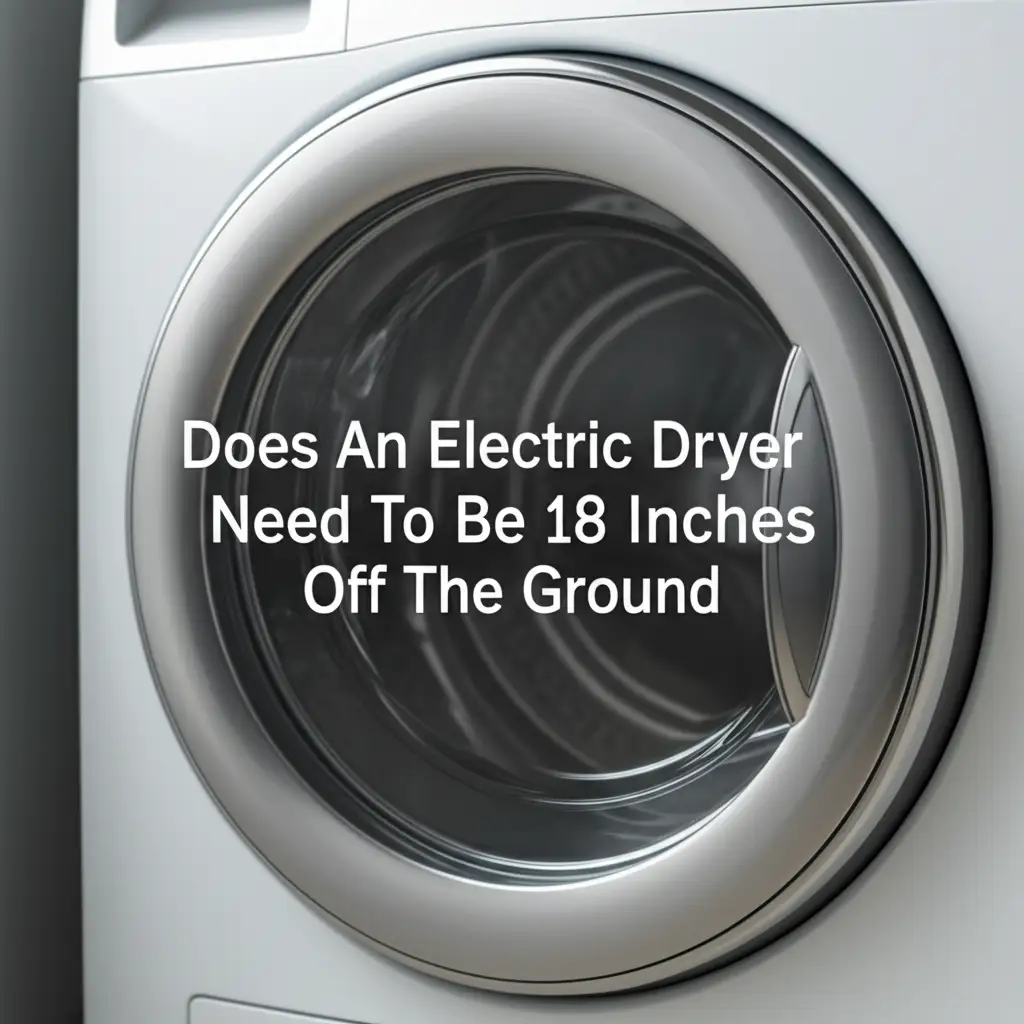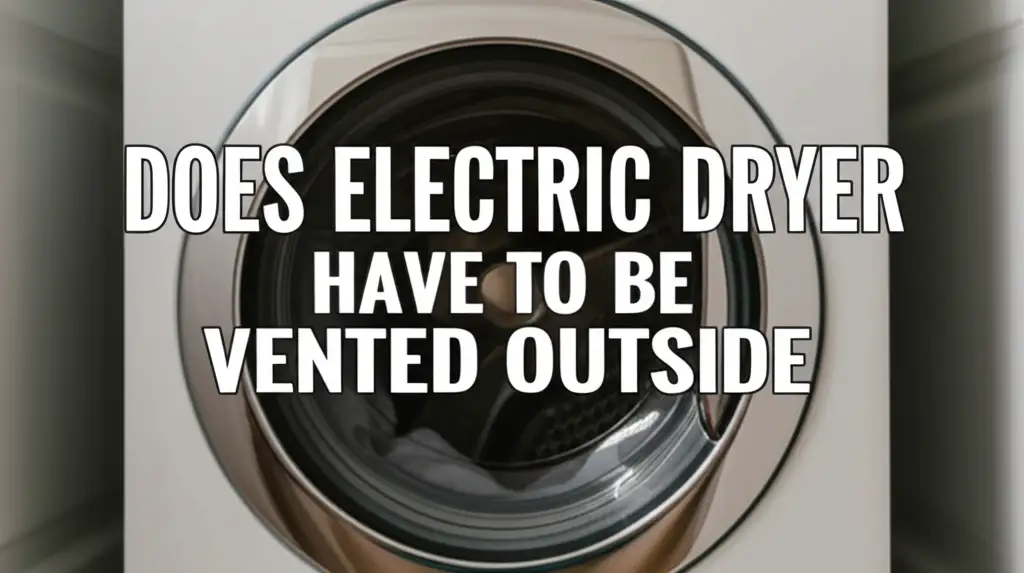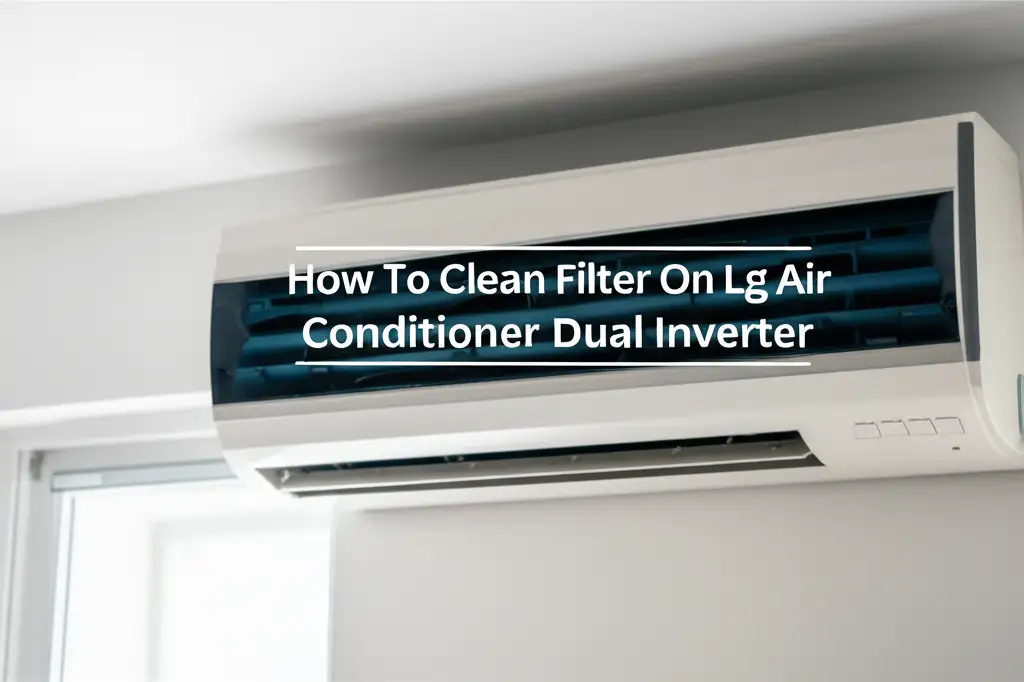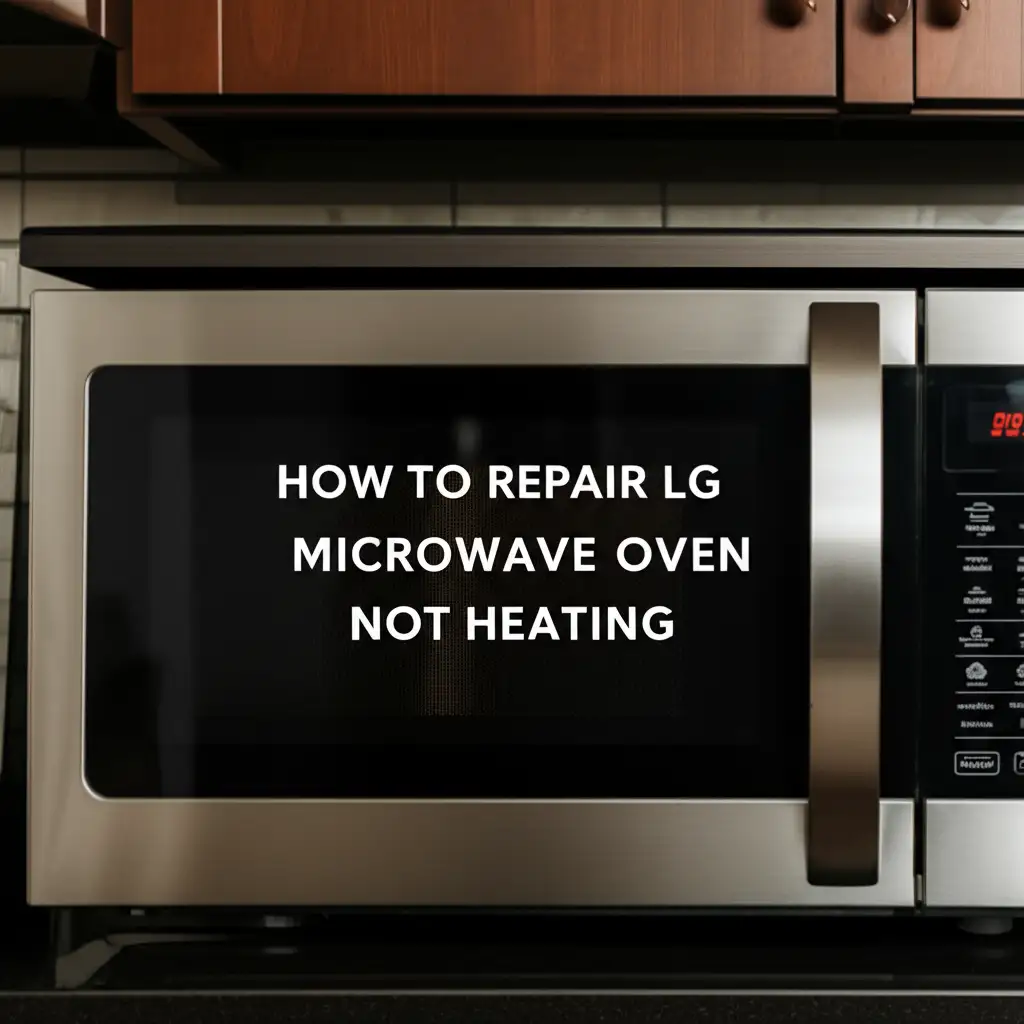· Davia Murnell · Home Appliances · 15 min read
Does An Electric Dryer Need To Be 18 Inches Off The Ground

Does Your Electric Dryer Need to Be 18 Inches Off the Ground?
When setting up new appliances, specific installation questions often arise. One common query many homeowners ask revolves around dryer placement: “Does an electric dryer need to be 18 inches off the ground?” This question causes confusion for many. I understand your concern about safety and proper installation. We want to ensure our homes are safe and our appliances work correctly. This article will clarify this particular requirement. We will discuss why this misconception exists, the true rules for electric dryers, and other vital safety considerations.
Takeaway:
- Electric dryers do not typically need to be 18 inches off the ground.
- The 18-inch rule applies to gas appliances in areas with potential flammable vapor buildup, like garages.
- Prioritize proper ventilation, electrical connections, and lint removal for electric dryer safety.
No, an electric dryer generally does not need to be 18 inches off the ground. This specific clearance requirement often applies to gas appliances in certain areas, particularly when located in a garage or utility room, due to the potential for ignition of flammable vapors. Electric dryers do not produce a flame.
Understanding the 18-Inch Rule: A Common Misconception
Many people wonder about specific appliance installation rules. The idea of an appliance needing to be 18 inches off the ground often comes up. This rule exists for a very good reason. However, it does not usually apply to electric dryers. This specific height requirement is for gas-fired appliances.
The rule typically applies to gas water heaters or furnaces installed in a garage. Garages can accumulate flammable vapors, such as gasoline fumes. These vapors are heavier than air. They tend to settle close to the floor. An open flame or pilot light, common in gas appliances, could ignite these vapors. Elevating the appliance 18 inches helps keep the ignition source above the typical height where these vapors collect. This greatly reduces the risk of an explosion or fire.
I often see homeowners apply this rule broadly to all appliances. This is a mistake. Electric dryers do not use an open flame. They do not have a pilot light. Therefore, the specific hazard that the 18-inch rule addresses does not exist with an electric dryer. Placing an electric dryer directly on the floor is generally safe. It also aligns with most manufacturer guidelines.
The confusion sometimes comes from general safety advice. People might hear “appliances in the garage need to be elevated.” They do not distinguish between gas and electric units. Always consider the specific type of appliance. Understand its power source and potential hazards. This helps ensure you follow the correct safety guidelines for your home.
Electric Dryers vs. Gas Dryers: Why the Rules Differ
Understanding the fundamental differences between electric and gas dryers is key. These differences directly explain why installation rules vary. Gas dryers operate by burning natural gas or propane. This process creates a flame inside the burner assembly. This flame generates the heat for drying clothes. Because a flame is present, gas dryers pose specific risks. These risks include potential gas leaks and the ignition of nearby flammable substances.
On the other hand, electric dryers use electric heating elements. These elements generate heat through resistance. They do not produce an open flame. There is no pilot light or burner assembly. This means electric dryers do not present the same ignition hazard as gas dryers. This critical distinction is why the 18-inch elevation rule does not apply to electric models.
Gas dryer vents also expel combustion byproducts. These byproducts include carbon monoxide. Proper venting is crucial for gas dryers to prevent harmful gas buildup inside the home. Electric dryers do not produce these combustion gases. Their vents primarily remove moist air and lint from the drum. While proper venting is still essential for electric dryers, the concern is moisture and lint, not toxic combustion gases.
Electrical requirements also differ greatly. Electric dryers need a dedicated 240-volt circuit. This provides enough power for the heating element. Gas dryers use a standard 120-volt outlet for their controls and motor. The heat comes from the gas line. These power source differences highlight the distinct operational principles of each dryer type. You must install each dryer according to its specific fuel type.
Actual Installation Requirements for Electric Dryers
Installing an electric dryer correctly is crucial for safety and performance. While the 18-inch elevation rule does not apply, other vital requirements exist. These rules ensure safe operation. They also make sure your dryer works efficiently. I always focus on these critical areas.
First, electrical power is paramount. An electric dryer needs a dedicated 240-volt circuit. This is a special high-voltage outlet. Standard household outlets are 120-volt. Using an adapter or incorrect wiring can be extremely dangerous. It can lead to overheating, electrical fires, or damage to the appliance. Always hire a qualified electrician if you are unsure about your home’s electrical capacity. They can ensure proper wiring and breaker size.
Second, ventilation is absolutely vital. Dryers work by removing moisture from clothes. This moisture, along with lint, exits through the dryer vent. The vent duct must be rigid metal. Flexible plastic or foil ducts can easily kink, trap lint, and pose a fire hazard. The duct should also be as short and straight as possible. It must vent directly to the outdoors. Proper venting prevents lint buildup, which is a leading cause of dryer fires. It also prevents moisture buildup inside your home, which can cause mold.
Third, ensure adequate clearance around the dryer. Manufacturers specify minimum clearances for air circulation. This allows heat to dissipate properly. It also provides space for maintenance. Blocking vents or placing items too close to the dryer can cause overheating. This reduces efficiency and creates a fire risk. Always check your dryer’s user manual for specific clearance instructions.
Finally, place your dryer on a level surface. An unlevel dryer can vibrate excessively. This leads to increased noise and wear on components. It can also cause the dryer to move during operation. Most dryers have adjustable feet. Use these to ensure the unit is perfectly level. Proper installation protects your home and your investment.
Why Some People Choose to Elevate Their Dryers
Even though electric dryers do not require elevation by code, many people choose to raise them. These decisions are typically driven by practical reasons. They improve convenience or optimize space. I often see homeowners elevate their dryers for several key benefits.
One major reason is ergonomics. Bending down to load and unload a dryer can strain your back. Elevating the dryer brings the door to a more comfortable height. This makes laundry tasks easier. It reduces physical stress. This is especially helpful for taller individuals or those with mobility issues. Many manufacturers offer pedestals specifically for this purpose. These pedestals also often include storage drawers underneath. This adds valuable organization space to your laundry area.
Another consideration is flood prevention, especially in basements or utility rooms. While not a primary code requirement, raising appliances can offer a small layer of protection. If a minor water leak occurs on the floor, the elevated dryer might avoid direct contact. This can prevent damage to the appliance. However, for significant flooding, elevation offers limited protection. You should always address the root cause of any water issue promptly.
Some homeowners also elevate dryers for aesthetic reasons. In modern laundry rooms, elevated appliances can create a more streamlined look. They can align the dryer’s height with a countertop or other cabinets. This contributes to a cohesive design. The added storage in pedestals helps declutter the space. This makes the laundry room more functional and visually appealing.
Finally, some people believe elevation might improve airflow or reduce noise. While manufacturers design dryers to operate efficiently on the floor, some perceive these minor benefits. The primary factors for airflow and noise are proper venting and level placement, not elevation itself. For example, ensuring your dryer’s exhaust vent is clear and clean is far more critical for airflow. How to clean your dryer provides helpful tips for maintaining optimal airflow and preventing lint buildup.
Crucial Safety Measures for Electric Dryer Operation
Operating an electric dryer safely involves several practices beyond initial installation. These measures reduce fire risks and prolong your dryer’s life. I always emphasize proactive safety habits for dryer owners. They are simple steps that make a big difference.
The most important safety measure is regular lint trap cleaning. The lint trap collects fibers from your clothes during each cycle. If the lint trap becomes clogged, it restricts airflow. This causes the dryer to work harder. It also allows heat to build up inside the dryer. This trapped heat, combined with highly flammable lint, creates a serious fire hazard. I recommend cleaning the lint trap before or after every single load. This only takes a few seconds.
Beyond the lint trap, you must also clean the dryer’s exhaust vent regularly. Lint can build up in the ductwork leading outside. This buildup similarly restricts airflow and increases fire risk. Depending on your laundry habits, cleaning the entire vent system once or twice a year is a good practice. You can use a brush kit designed for dryer vents. Or you can hire a professional to do it. A clear vent ensures efficient drying and safety. For detailed instructions, you might find articles like How to Clean Dryer Machine very useful.
Do not overload your dryer. Overloading prevents clothes from tumbling freely. This increases drying time. It also puts stress on the motor and heating elements. This can lead to overheating. Always follow the manufacturer’s guidelines for load capacity. Leave enough space for clothes to move around. This allows warm air to circulate effectively.
Also, avoid drying items that are soiled with flammable substances. Clothes with gasoline, cooking oil, or chemicals can spontaneously combust in the dryer. If you must wash such items, air dry them instead. If they must go in the dryer, run them through several wash cycles first. Then, dry them on a low heat setting.
Finally, check the dryer’s electrical cord and outlet periodically. Look for signs of wear, fraying, or discoloration. A damaged cord can cause electrical shorts or fires. Never use an extension cord with a dryer. Dryers draw a lot of power. Extension cords are not designed for such high loads. They can overheat and become a fire hazard.
Checking Local Codes and Consulting Professionals
While general appliance installation guidelines exist, local building codes are essential. These codes can vary significantly from one city or county to another. What is acceptable in one area might not be in another. I always advise homeowners to check their specific local regulations. This step ensures full compliance and safety.
Local codes often cover detailed aspects of appliance installation. This includes electrical wiring requirements, venting standards, and specific clearances. For instance, some areas might have stricter rules for dryer vent materials or lengths. They might also require specific permits for appliance installation or electrical work. Failing to comply with local codes can result in fines. It can also lead to issues with home insurance or resale.
You can usually find local building codes on your city or county government website. Many municipalities have a building department. This department provides information to the public. You can call them directly with your questions. They can provide accurate and up-to-date information for your specific location.
For complex installations or if you are unsure, consulting a professional is always the best approach. A licensed electrician can assess your home’s electrical system. They can ensure your dryer has the proper dedicated circuit and wiring. This is especially important for 240-volt electric dryers. They understand all the national and local electrical codes. Their expertise ensures a safe and compliant setup.
Similarly, a professional appliance installer can ensure your dryer is properly vented. They know the correct duct materials and routing. They can also ensure the dryer is level and has adequate clearance. Many appliance stores offer installation services. These services come with trained and certified technicians. Investing in professional installation provides peace of mind. It also protects your home and appliance from potential hazards.
Maintaining Your Electric Dryer for Longevity and Safety
Proper maintenance extends your electric dryer’s life. It also keeps your home safe. A well-maintained dryer runs more efficiently. It consumes less energy. I believe consistent maintenance is key for any appliance. It prevents small issues from becoming big problems.
Start with the basics. Clean the lint filter before or after every load. This simple step is the most important one. A clean filter allows air to flow freely. This means clothes dry faster. It also prevents lint buildup inside the machine. Lint is highly flammable. A clogged filter is a leading cause of dryer fires.
Next, periodically inspect the dryer vent hose. This is the duct that connects the dryer to the outside. Look for kinks, crushes, or tears. These can restrict airflow. The hose should be rigid metal for the best safety and efficiency. Flexible plastic or foil hoses are fire hazards and collect lint easily. Replace any damaged hoses immediately.
Clean the dryer vent ductwork regularly. Lint can accumulate inside the duct over time, even with a clean lint filter. This buildup reduces airflow and creates a fire risk. You can buy a dryer vent cleaning kit. These kits include a long brush that attaches to a drill. I recommend cleaning the entire vent system at least once a year. If you use your dryer heavily, clean it more often. Sometimes, professional vent cleaning is a good investment.
Also, check the dryer’s exterior vents. Make sure the outdoor vent flap opens and closes properly. Birds or pests can build nests in the vent opening. Leaves and debris can also block it. A blocked outdoor vent stops moist air from escaping. This makes your dryer less efficient. It also causes heat buildup inside the machine.
Finally, keep the area around your dryer clear. Do not store flammable liquids or materials near it. Ensure there is enough space for proper air circulation. This prevents the dryer from overheating. Regular maintenance prevents unexpected breakdowns. It also gives you confidence that your dryer operates safely. For specific guidance on cleaning different parts of your dryer, resources like How to Clean a GE Dryer can offer model-specific tips.
Frequently Asked Questions
Does an electric dryer require a dedicated circuit?
Yes, an electric dryer requires a dedicated 240-volt circuit. This is a specific electrical connection that provides sufficient power. Using a standard 120-volt outlet or an extension cord is unsafe. It can damage the dryer or cause an electrical fire. Always ensure proper electrical hookup.
Can an electric dryer be installed in a garage?
Yes, an electric dryer can be installed in a garage. Unlike gas dryers, electric models do not have an open flame or pilot light. This means they do not pose the same ignition risk for flammable vapors that might collect near the floor in a garage. Always ensure proper ventilation and electrical connections.
What is the biggest fire hazard with electric dryers?
The biggest fire hazard with electric dryers is lint buildup. Lint is highly flammable. When it accumulates in the lint trap or the exhaust vent duct, it restricts airflow. This causes the dryer to overheat. This combination of heat and lint can easily ignite, leading to a dryer fire.
How often should I clean my dryer vent?
You should clean your dryer’s lint trap before or after every load. For the main dryer vent ductwork leading outside, clean it at least once a year. If you use your dryer frequently, or if drying times seem longer, consider cleaning the ductwork more often. Regular cleaning prevents lint buildup and fire hazards.
Do I need a permit to install an electric dryer?
Generally, installing a replacement electric dryer in an existing dedicated outlet does not require a permit. However, if you need to install a new 240-volt circuit, move the dryer to a new location requiring new wiring, or modify the exhaust system, you might need an electrical or building permit. Always check local building codes.
What clearances does an electric dryer need?
Electric dryers need specific clearances for proper airflow and safety. Manufacturers provide minimum clearance requirements in the user manual. Typically, this includes a few inches of space around the sides, back, and top for ventilation. Never push the dryer flush against a wall or block its exhaust vent.
Conclusion
The question “Does an electric dryer need to be 18 inches off the ground?” is a common one, but the simple answer is no. This specific rule applies to gas appliances in certain locations. It addresses the risk of igniting heavy flammable vapors. Electric dryers do not use an open flame. Therefore, this particular safety concern does not apply to them.
While elevation is not a requirement for electric dryers, proper installation and maintenance are paramount. Always ensure your electric dryer has a dedicated 240-volt circuit. Verify that the dryer vent uses rigid metal ductwork and exhausts directly outdoors. Regular lint trap cleaning and periodic vent cleaning are vital to prevent fire hazards. Following these guidelines ensures safe and efficient operation of your electric dryer for years to come. If you have any doubts about installation or safety, consulting a qualified electrician or appliance professional is always a smart choice for peace of mind.





